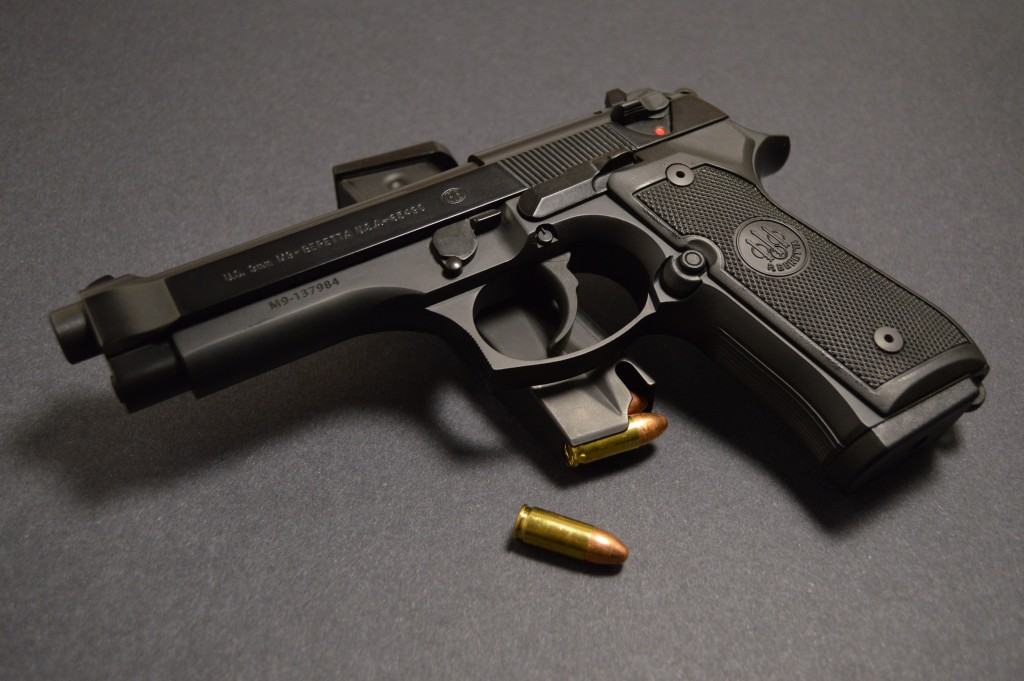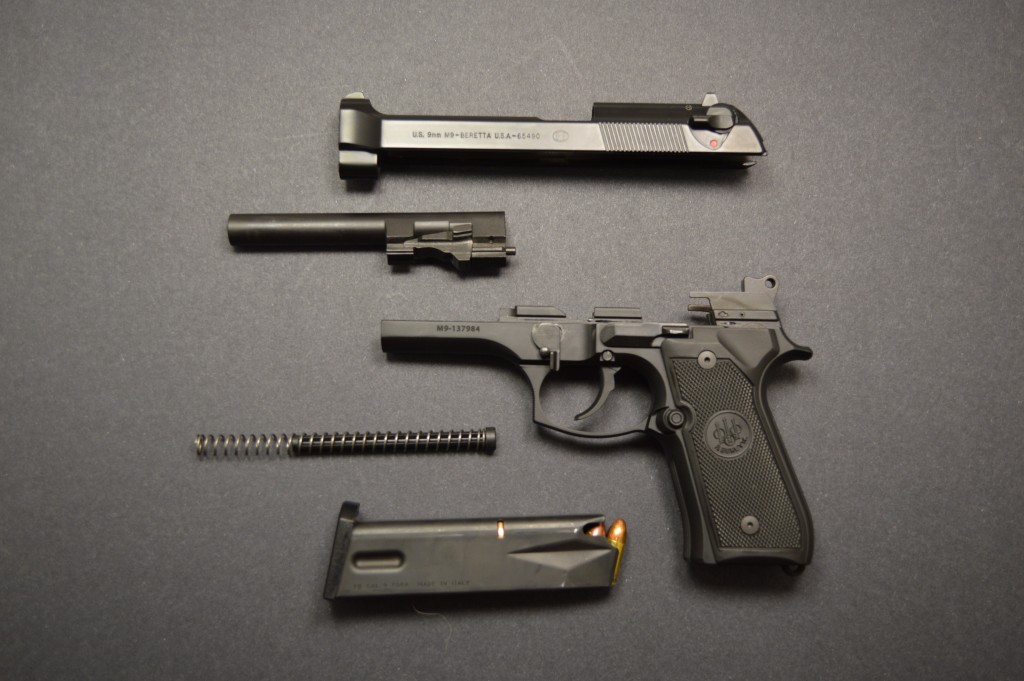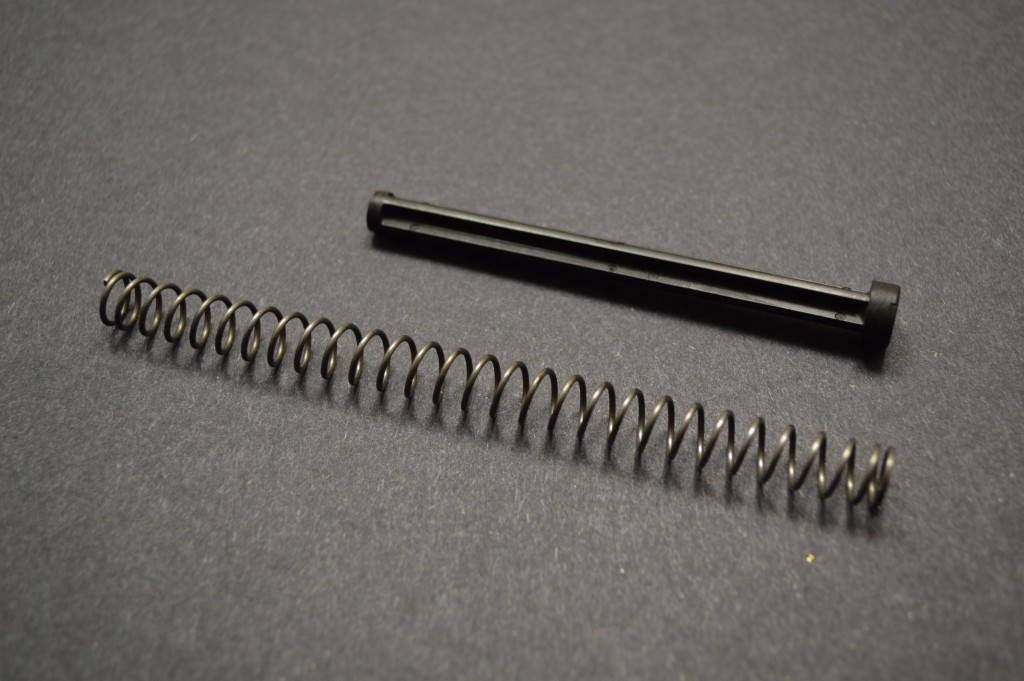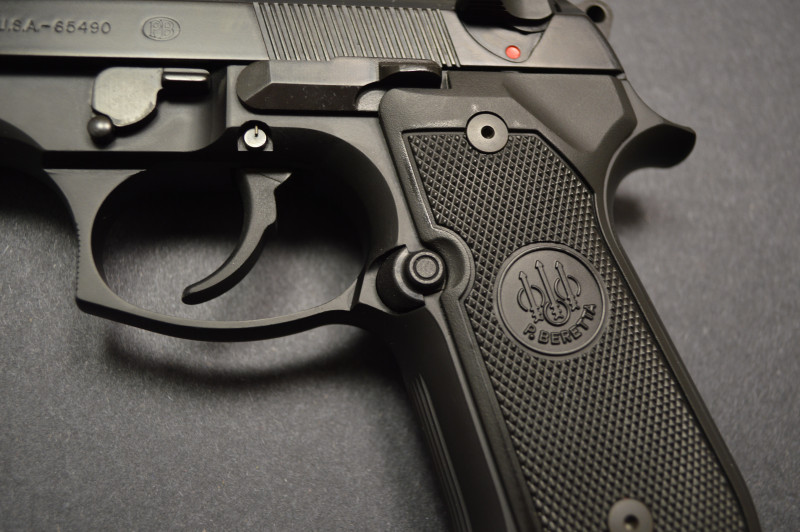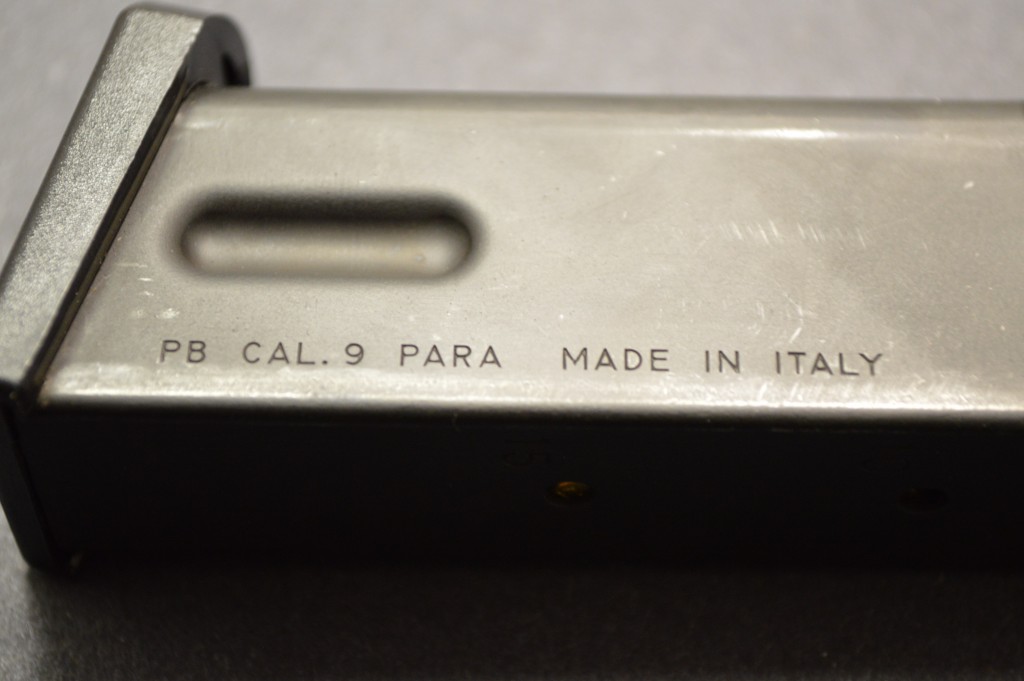Beretta M9 Review
When I was a freshman in high-school, I went through a period of serious interest in airsoft replicas. Having come from the paintball world, I appreciated the increased realism and more accurate manuals of arms offered by airsoft guns. Growing up in a very non-gun house, airsoft felt like the closest to real firearms that I was going to get. Toward the end of my involvement, ultra-realistic gas blowback guns were my favorites as they not only offered realistic magazine capacities, but also featured semi-realistic blowback operation that generated noticeable recoil. One of my favorites was the Beretta M9 made by Kwan Ju Works (KJW), a popular Taiwanese airsoft manufacturer.
Jumping forward to 2012, when I began looking for my first handgun as a 21 year old, I found myself once again drawn to the M9. The Beretta’s unique open-slide design and general aesthetic superiority over other modern handguns make it, in my opinion, one of the most attractive firearms on the market. These characteristics combined with its status as the primary sidearm of the U.S. Military ultimately influenced me to purchase one new from Bud’s Gun Shop in May of 2012 for around $520 shipped.
About the Pistol
Operated by the Beretta family since 1529, Beretta has experienced just about every firearms innovation dating back to the Renaissance. That a company can persist under the same family through such drastic political and economic change as that seen since 1500s Europe is nothing short of remarkable.
Returning to the present, the 9x19mm Beretta M9 was adopted by the U.S. Military in 1985 to replace the aging 1911A1, after narrowly nudging out the SIG P226. An incremental upgrade of the Beretta 92 series developed in the 1970s, the M9 uses a similar locked breech and open slide design to that found in the famous German P38 from World War II. Such a design is allegedly more accurate than the Browning cam-style action popularized by the 1911. The M9 also bears a striking resemblance to the Beretta Model 1951 and in fact operates much the same way, but features a double stack magazine as well as a double and single action trigger. My commercial version of the M9 came in a cardboard box with a camouflage sleeve and included two 15-round magazines. My understanding is that the M9 now ships in a plastic case.
Design
The locked breech of the M9 is certainly a unique design almost exclusively used by Beretta in contemporary handguns. Upon firing, the slide begins to cycle rearward almost immediately as pressure-induced recoil attempts to eject the spent casing from the chamber. In order to ensure that chamber pressure has sufficient time to dissipate, the barrel joins the slide in this rearward motion. Meanwhile, the locking block attached to the barrel increasingly hinges downward throughout this motion until it collides with a reinforced section of the frame, just forward of the magazine well. Once this contact is made, the barrel uncouples from the slide for casing ejection.
Because the barrel does not tilt as in a cam-style action, this recoil motion is very fluid. The slide truly feels as though it is on ball bearings. The reduced rotational momentum and overall heft of the firearm also contribute to the relatively light recoil of the M9. Disassembly of the M9 is as simple as pressing the locking button on the right of the frame just forward of the trigger and rotating the lever at the same spot on the left side clockwise. The slide assembly can then be pushed forward and off the rails.
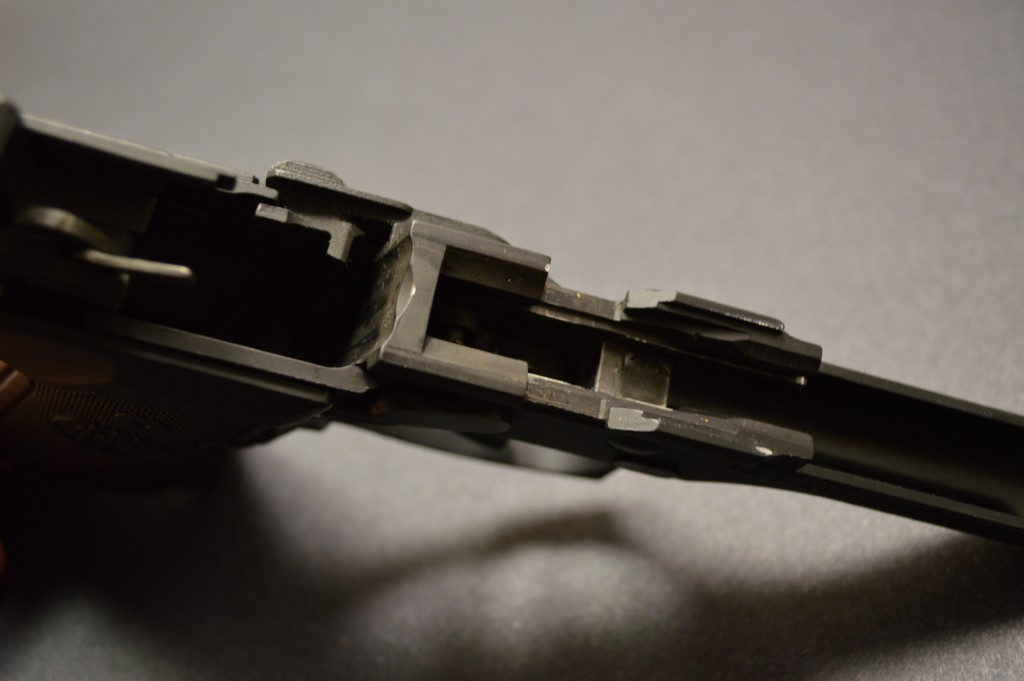

Unlike many more modern handguns, the M9 uses a single, non-captive recoil spring. This spring travels on a polymer guide rod in newer pistols while older examples feature steel rods. Beretta and their supporters claim that the new, fluted polymer rod is more debris resistant and every bit as durable as the old steel part. Frankly, I am not sure I subscribe to either theory, but am also unconcerned about the durability of my polymer guide rod. I tend to believe that this change was made as a cost reduction and not necessarily as an improvement.
Much like the guide rod, the trigger on current M9s is also polymer. That said, the polymer on the trigger is actually just a coating over what is internally a steel part. I am ambivalent about the polymer trigger, but am impressed with the glass-like single-action break. The double-action pull of the M9’s trigger is heavy at around 12 or 13 lbs and a little too long for my tastes. The 5 lb single-action pull is very nice, albeit still a bit long, with little over travel and an audible reset of around 4 or 5mm. The M9’s mainspring can be swapped with the same part from the 92D double-action only (DAO) handgun for a reduction of around 2 lbs in double-action and about 1 lb in single-action mode. I have yet to make this change on my handgun. While I am impressed by the crisp break of the M9’s trigger, I am not a fan of its extremely short reach distance on single-action mode and find that the convex, narrow trigger face makes the double-action pull feel worse than it really is.
Although the manual safety is every bit as much an external feature as it is an internal one, it is important to discuss how this part works from a functional perspective. As the slide-mounted safety/decocker rotates counter-clockwise, part of the inertial firing pin turns up and out of the hammer’s range of motion. As soon as this piece is out of the way, the hammer falls and the handgun safely decocks. The M9 has three conditions: cocked and ready to fire, decocked and ready to fire, and decocked and safe.

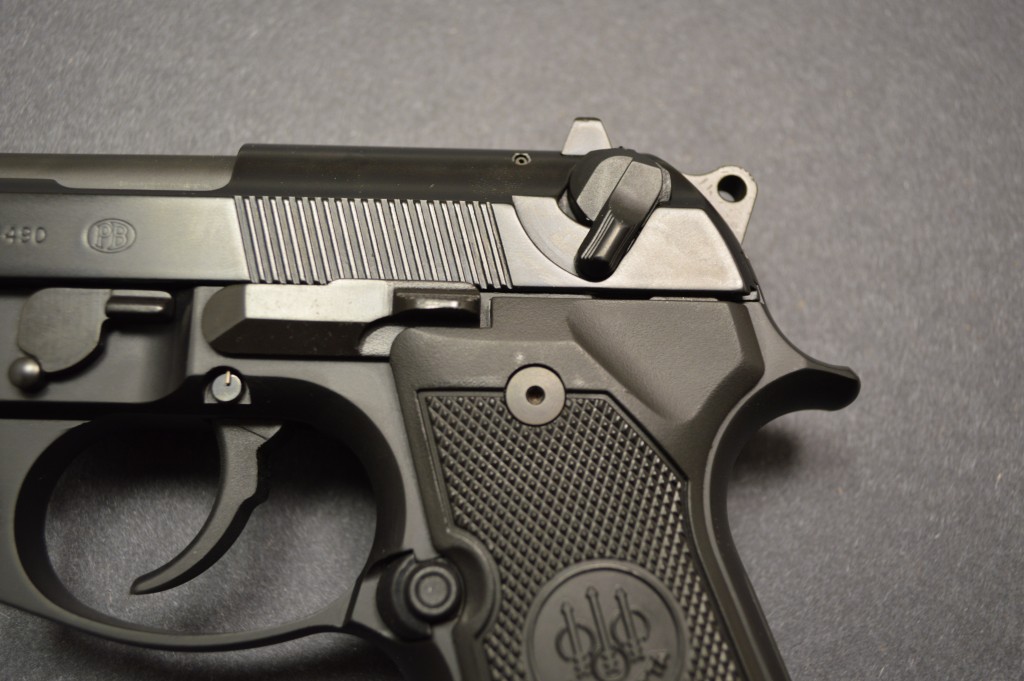
Finish & Controls
From a finish perspective, the M9 is a bit of a mixed bag. The slide features Beretta’s proprietary Brunitron finish. Brunitron is a tough, inky black finish that features incredible lubricity and has the appearance of paint. In fact, the lubricity of the Brunitron finish is so great that racking the slide using even the rear serrations can be slippery. The M9’s frame is anodized aluminum alloy while the barrel is chrome lined and blued. I have found that in unusually humid environments, the blued barrel rusts rather quickly; so buyers will want to keep the M9 stored somewhere especially dry.
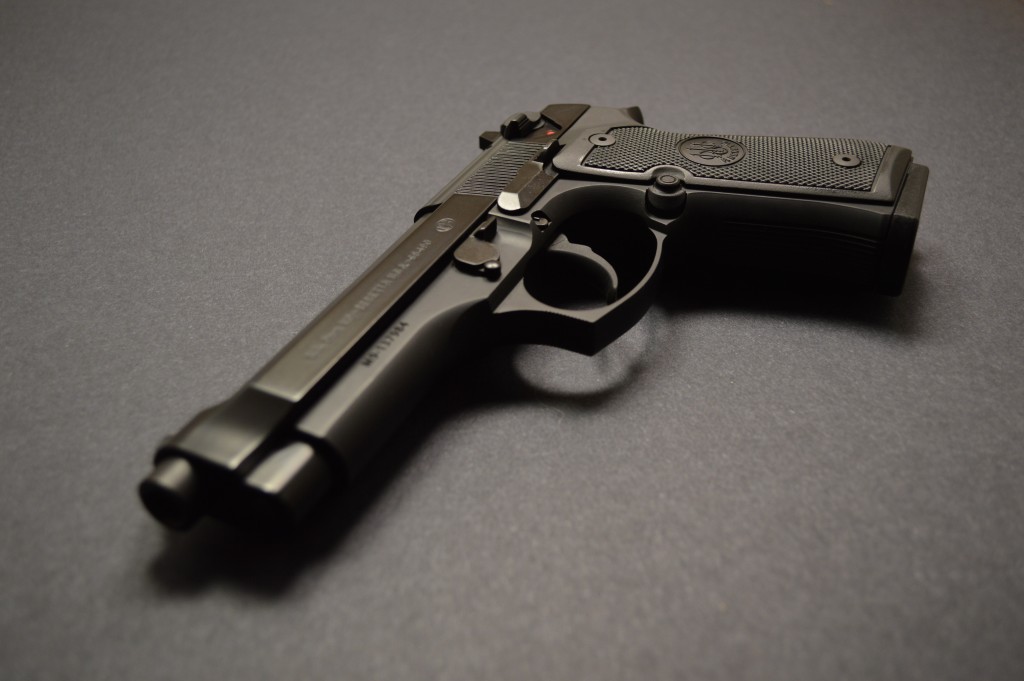
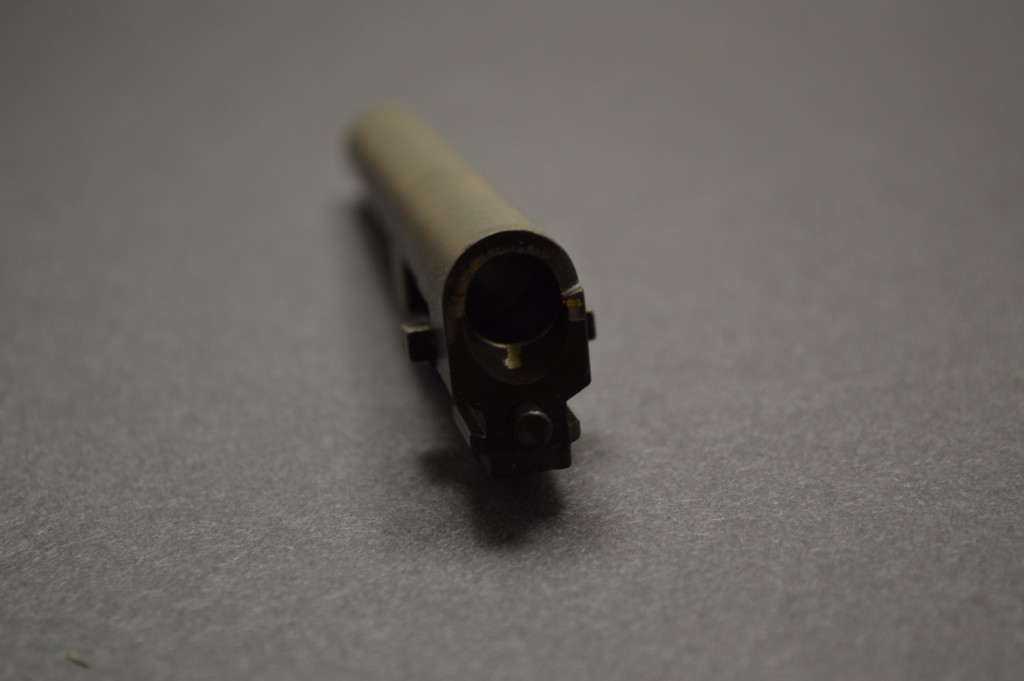
The grip panels on the M9 are run-of-the-mill checkered polymer panels with a prominent Beretta seal centrally located. I have found these panels to be acceptable for pretty much any usage environment. However, thinner and more aggressively textured grip panels are available through popular vendors, such as Hogue and VZ Grips.
The M9’s detractors frequently point to the grip as a major deficiency. Many say that it is larger than other service pistols and that it does not work for people with small hands. With those people, I must respectfully disagree. Based on my measurements at the trigger, center of the grip, and base of the grip, the M9’s grip circumference is within a millimeter or two of several popular handguns, including Glocks, FNs (FNX/FNP), and HK USPs. Where there is a difference is in the width of the M9’s grip in comparison to other options. As a result of the grip panels resting on top of an alloy frame, the M9 features a wider grip than other options. However from front-strap to back-strap, the Beretta is actually slimmer than its peers. I also have found that the more contoured, softer-edged grip of the M9 is more comfortable than the utilitarian approach taken by Glock, for example.

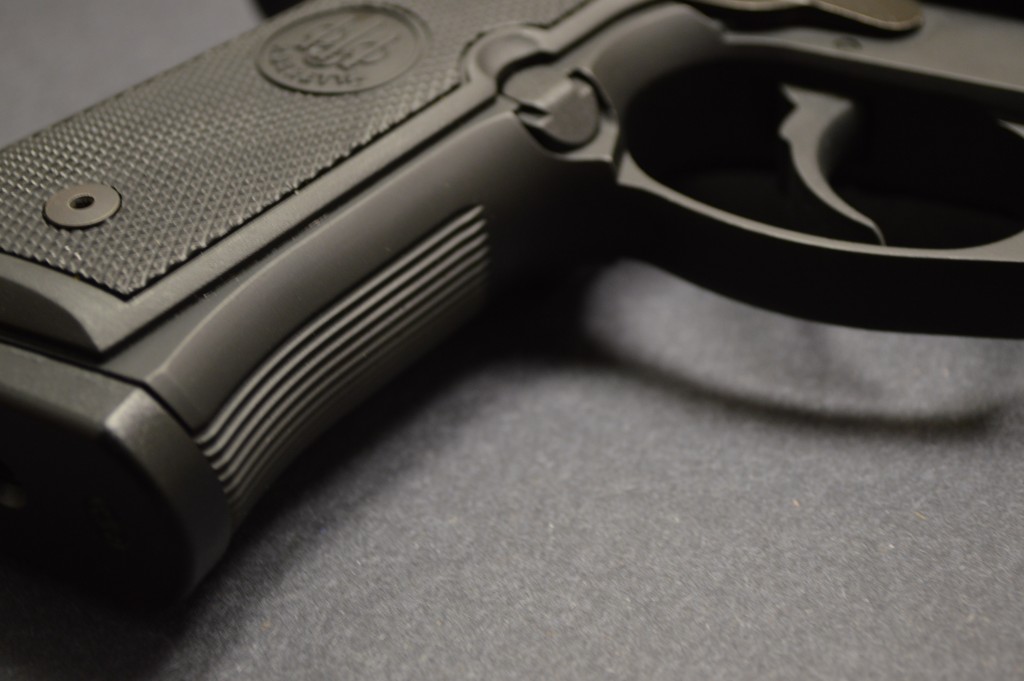
Perhaps the most maligned part of the 92/M9 series handguns is the slide-mounted safety. A quick internet search will easily yield numerous results where people are inevitably complaining about two main issues. The first is that shooters who like to “slingshot” the slide to reload after an empty magazine often accidentally activate the safety, which decocks the pistol upon return to battery. The second common complaint is that the safety is (in some peoples’ opinion) oriented backwards. Some think that the downward position should be fire while the upward position should be safe. In my opinion, both issues are overblown. The first is easily overcome by using the slide release lever to return the firearm to battery, while the second complaint is merely an opinion that is likely held by those more familiar with frame mounted safeties.

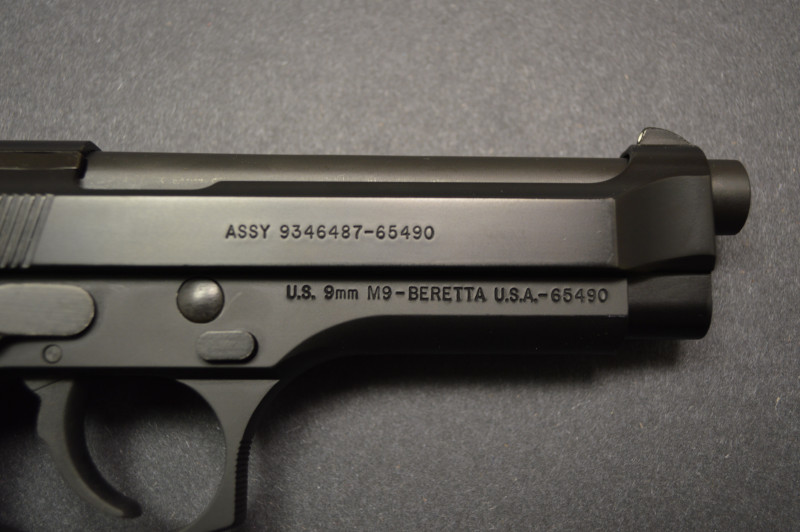
Some might wonder how the M9 differs from the 92FS also available from Beretta. Outside of different markings and packaging, the M9 also features a straight dustcover and a non-radiused grip. Another notable difference is that the M9 uses i-dot sights rather than the standard 3-dot system.
Sights
From a sights standpoint, the M9 is a noticeable departure from its 92 series brethren. Whereas most pistols these days feature 3-dot sights with two dots in the rear and one on the front sight, the M9 has a single rear rectangular/semi-circular mark and a single front dot. Rather than line up three dots on a single plane, the M9’s sights simply require users to place the white front dot above the white rear post to accurately aim the handgun. I find this to be a quicker arrangement as the sight picture is slightly less cluttered than that of 3-dot systems.

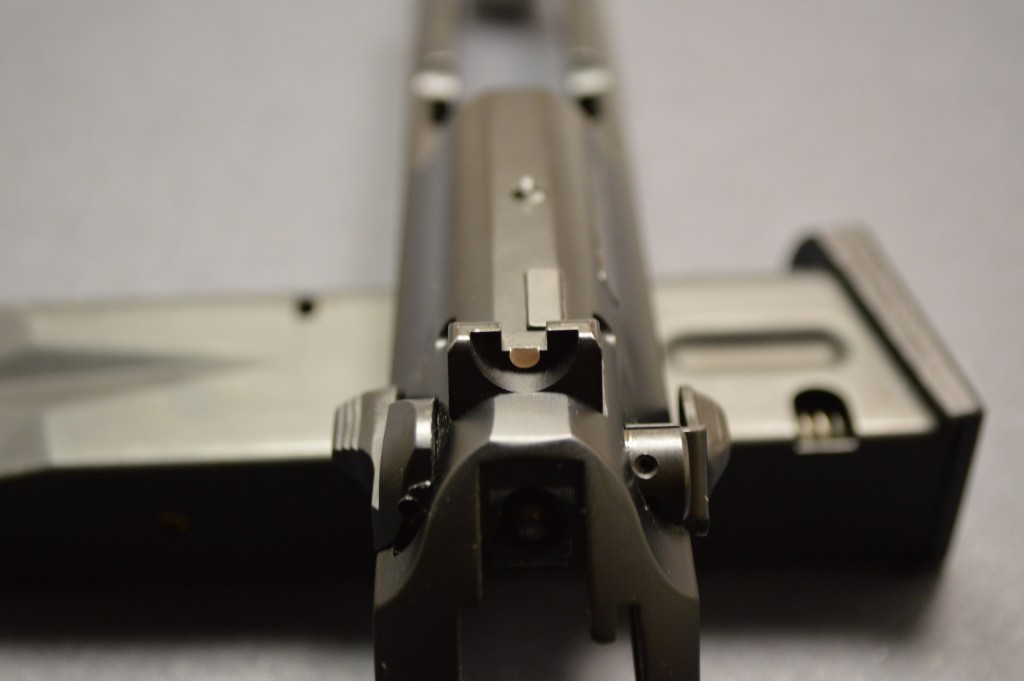
Magazines
The M9 ships with two 15-round magazines. The provided magazines are constructed of steel and are phosphated to provide some corrosion resistance. The finish wears rather easily on these and they will rust in humid environments. Beretta also sells a sand and corrosion resistant version of the M9 magazine that features a Physical Vapor Deposition (PVD) finish. These are identifiable by their gray, almost NiB-X, finish.
In addition to the finish options, Beretta now sells a 17-round, flush-fit magazine that was originally designed for the M9A1 and 92A1 pistols. These magazines work perfectly fine in the original M9/92s as well. Like other manufacturers, Beretta magazines have holes in the rear to assist in counting the number of rounds within.
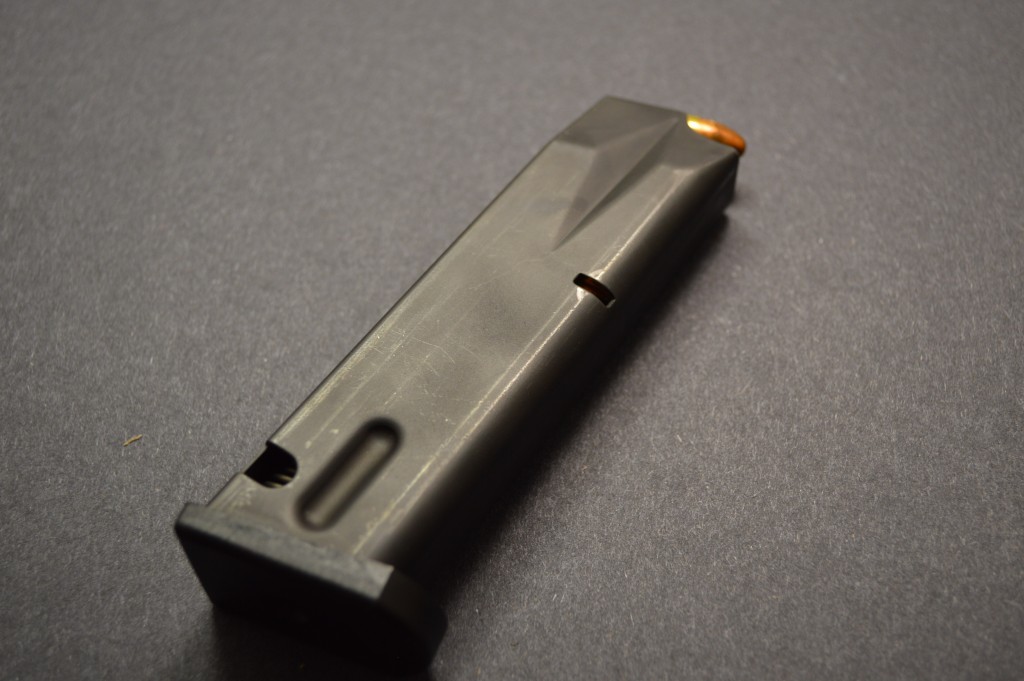
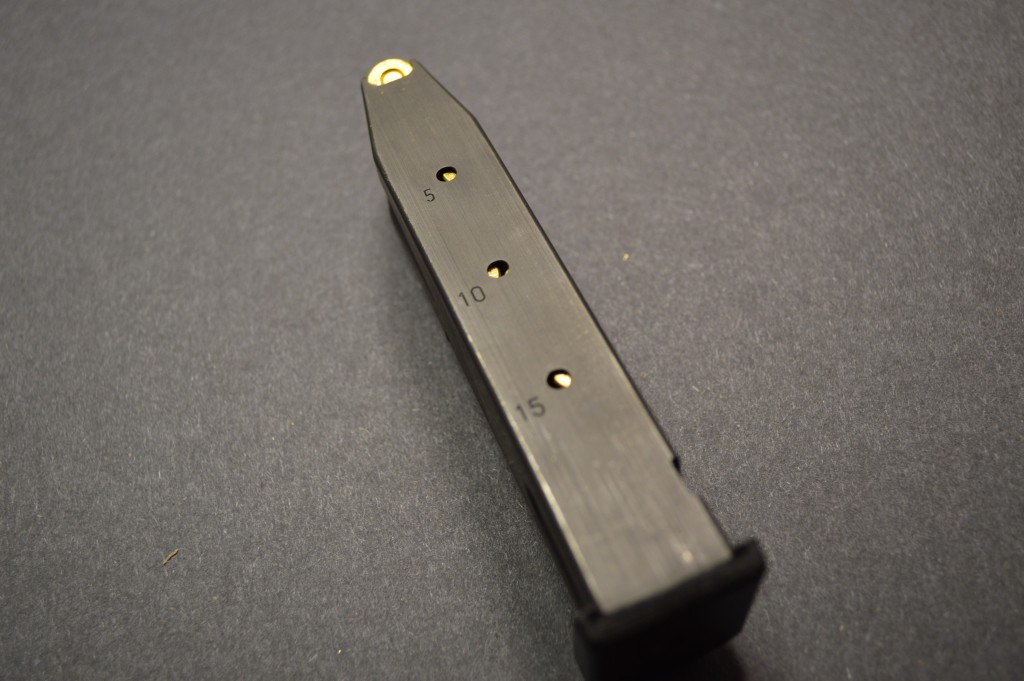
Before moving on, we should take a moment to discuss the several aftermarket options available for the M9/92 series handguns. The three most popular are Beretta factory (actually Meccanica del Sarca, or MDS), Mec-Gar, and Checkmate Industries. Both the Beretta/MDS and Mec-Gar products receive very good reviews and are recommended both in the 15-round and 17-round capacities. Checkmate began manufacturing the magazines a few years ago as part of a government contract. These magazines have a reputation for being unreliable in harsh environments. While the Checkmate magazines may make for decent range parts, I would stick with the Beretta/MDS or Mec-Gar offerings for defensive use.
Range Report
Like a few of the firearms I have reviewed here, the M9 has made so many range trips with me that I cannot confine this section to a single “test” trip. Rather, I will share my experience with the handgun as a whole in an effort to highlight both the positive aspects and frustration points that have cropped up during my time with the M9. Fortunately, I have also introduced several new shooters using this handgun and can share some of their feedback as well.
The first notable characteristic that comes in to play when shooting the M9 is its overall heft. The pistol is by no means light and anyone looking to holster it for carry will want to make sure their belt fits very well. However on the range, this bulk can be a blessing. Muzzle rise with the M9 is very manageable as a result of its locked breech operation and weight. In my experience, new shooters have almost unanimously approved of the M9 for this very reason.
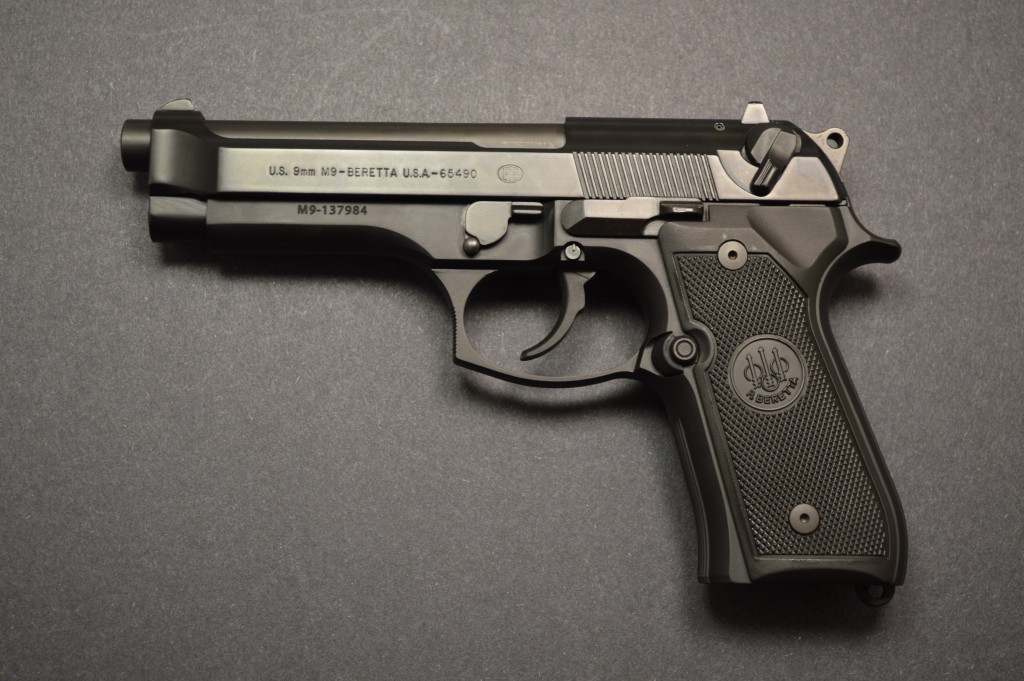
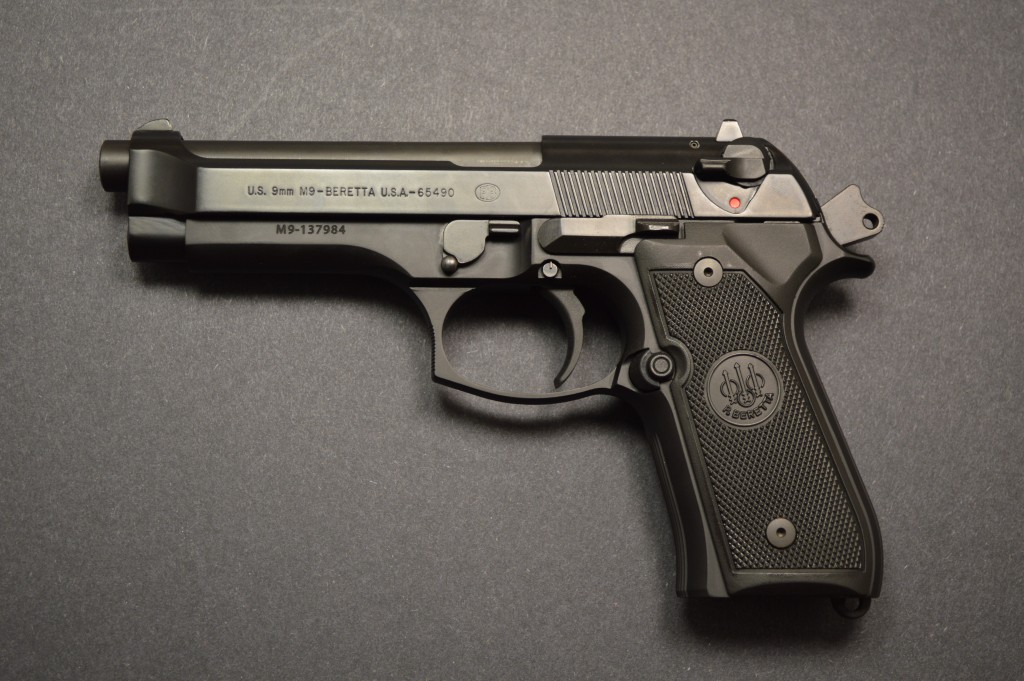
From an accuracy standpoint, the pistol is more than acceptable. I cannot say if the M9 is any more accurate than your average cam-action pistol, but in capable hands, it can be a very effective sidearm. You may remember I previously complained about the trigger. I still am no fan of this part, however a distinction must be made between precision and accuracy. The M9 is a very precise pistol that I just happen to shoot somewhat inaccurately. With this handgun, I tend to push my shots left of my point of aim (POA).
Conclusion
The Beretta M9 is a solid service handgun with a respectable track record for reliability among both civilian and military users. Most issues can be avoided by properly maintaining the pistol and using quality magazines. Though I have found that I perform better with other handguns, I have no regrets about having chosen the M9 as my first pistol.
Plus-Minus
+ Reliable
+ Attractive
+ Smooth operation
+ Parts availability
+ Accurate
+ Good SA trigger weight
– Poor trigger geometry
– Heavy DA trigger pull
– Heavy for carry
– Slippery slide (no pun intended)
An information security professional by day and gun blogger by night, Nathan started his firearms journey at 16 years old as a collector of C&R rifles. These days, you’re likely to find him shooting something a bit more modern – and usually equipped with a suppressor – but his passion for firearms with military heritage has never waned. Over the last five years, Nathan has written about a variety of firearms topics, including Second Amendment politics and gun and gear reviews. When he isn’t shooting or writing, Nathan nerds out over computers, 3D printing, and Star Wars.

